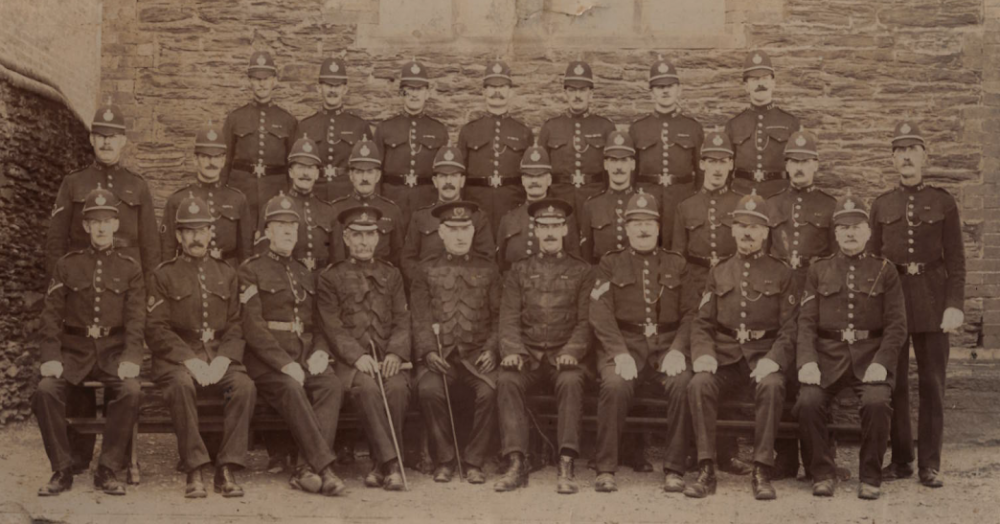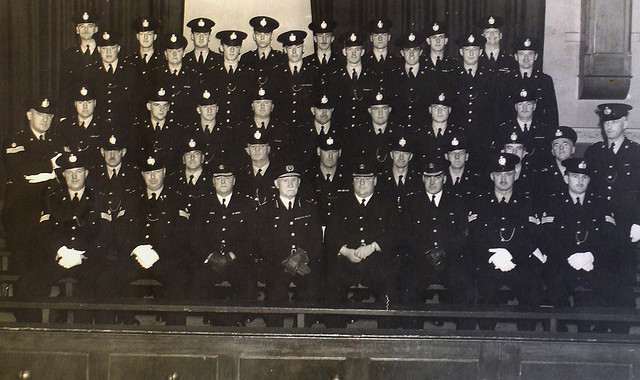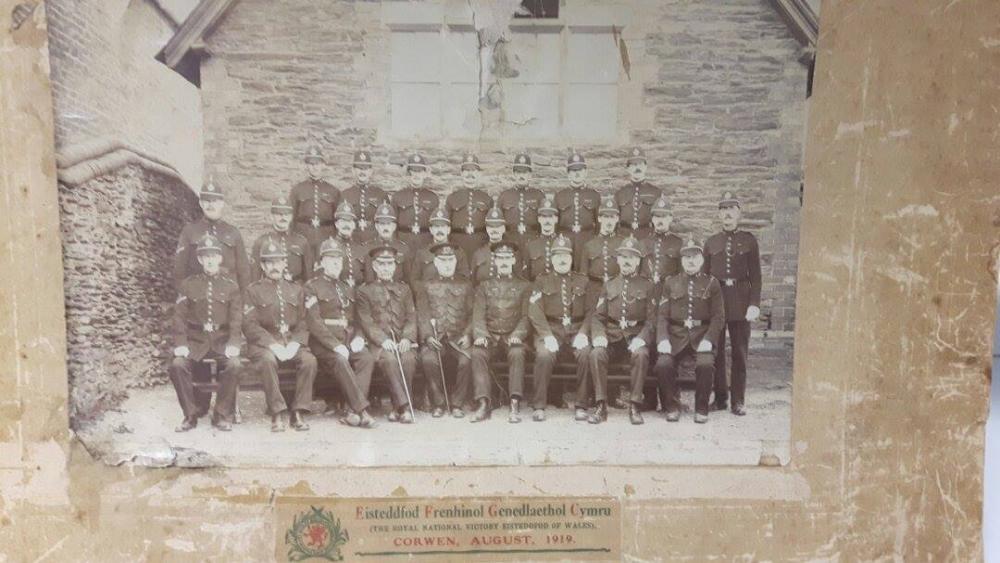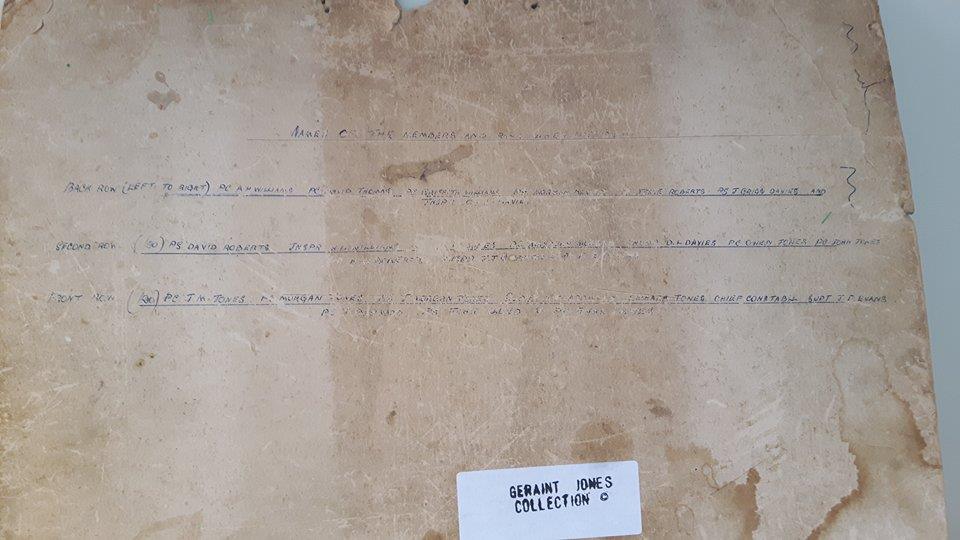-
Posts
3,518 -
Joined
-
Last visited
-
Days Won
27
Content Type
Profiles
Forums
Blogs
Gallery
Events
Store
Posts posted by bigjarofwasps
-
-
-
Just out of interest, how easy is it to research City of London Police Officers, who were awarded the 1887 & 1897 Jubilee Medals?
0 -
Just out of interest how easy is it to research City of London Police Officers, who were awarded the 1887 & 1897 Jubilee Medals?
0 -
-
The names of the officers in the photo have been written on the back of the photo, at some point.
*** denote were the print was so worn it can't be made out.
italics denote were the text was very poor condition and I've made an educated guess as to what I think it could be.
Sadly some of officers we'll never know what their names are (from this source anyway) as the text is totally worn out.
Back Row Left to Right
PC A H WILLIAMS
PC David THOMAS
PC Griffith WILLIAMS
PC Morgan DAVIES
PC Jesse ROBERTS
PS Grigg DAVIES
Insp O C Davies
Second Row Left to Right
PS David ROBERTS
Insp W D WILLIAMS
***** JONES
PC Maybury MO***** (MORRIS)
Insp D L DAVIES
PC Owen JONES
PC John JONES
** R D ROBERTS
*** J J GRIFFITHS
** E ********
Front Row Left to Right
PC J M JONES
PC Morgan JONES
PS J MORGAN JONES
SUPT D T *********
Chief Constable Richard JONES
SUPT J F EVANS
PS J BERNARD
PS John LLOYD
PC Evan DAVIES
0 -
Am curious to know if a US service person, was awarded a British medal (say a Military Cross), what would the order of wear be? Would it be worn before US campaign medals but after US gallantry medals or worn after all US medals?
0 -
On 5/6/2016 at 10:47, paul wood said:
It would be named with his rank, name and unit
Paul
Interesting. So by that rational would an off duty police constable's George Medal be named to PC **** Met Police?
0 -
-
I was researching something else when I cam across this..
I'm curious to know whether the medal would be awarded to Capt Gold RAMC or just Mark Gold? As I'm assuming he was home of leave at the time (and off duty?) Assuming it's named to Capt Gold RAMC would the same be true if he'd been a Constable or Firefighter who was off duty?
0 -
On 4/20/2016 at 19:08, Dave Wilkinson said:
This is the final force photograph of the entire Merionethshire Constabulary taken on the 30th September 1950. At midnight the force ceased to exist. Chief Constable Richard Jones retired at the same time. As an aside, they ceased to wear helmets at the end of the 2nd WW. Fourth from the right on the back row is Constable Arthur Rowlands who years later was to be awarded the George Medal following his being shot in the face (and blinded) by a suspected burglar, Robert Boynton.
Dave.
Thanks Dave, that's really interesting & sad at the same time. Especially with regards to PC Rowlands. I'd be interested to know more about the incident, where did it occur. With the subsequent amalgamations does this mean that NWP can claim his George Medal?
I seem to recall seeing a KPM (gallantry) in a display case in Wrexham station years ago. Not sure whose it was or what the circumstances of it where either?
http://www.independent.co.uk/news/obituaries/arthur-rowlands-policeman-who-was-awarded-the-george-medal-8468693.html This newspaper report suggests that "He and the three colleagues who arrested his assailant were awarded the George Medal." Are the other two Officers known?
On 4/18/2016 at 19:48, bigjarofwasps said:Here's a photograph of the names on the rear of this picture. You can just make out a few of the names, some of them are really difficult to make out when your looking at it directly. But I'll try and copy them out, from the original when I get a minute.
0 -
17 hours ago, Tom King said:
Thats because the London Docks were commercial docks.
The docks that the Met were responsible for were all were Royal Navy dockyards. So they were responsible for the security and policing of naval dockyards, not commercial enterprise.
Cheers Tom makes perfect sense now!!!!
Can you or anyone else answer my other question?
"Due to the fact that these Divisions came under Metropolitan Police, is the research potential for their officers the same for them as regards, service papers, etc. Where all the officers trained in London and then posted to these divisions or where they trained locally"?
0 -
On 5/2/2016 at 15:10, Dave Wilkinson said:
Can't comment upon the first part of your question. However, the Docks in London were owned by the Port of London Authority and were policed by their own non-Home Office police force.
Dave.
Thanks Dave, that is very interesting. Curious how the docks within the Met area weren't covered by the Met but ones as a far a field as Wales were?
0 -
On 1/21/2015 at 20:34, Tom King said:
1st Division: Woolwich
2nd Division: Portsmouth
3rd Division: Devonport
4th Division: Chatham
5th Division: Pembroke
6th Division: Rosyth
Due to the fact that these Divisions came under Metropolitan Police, is the research potential for their officers the same for them as regards, service papers, etc. Where all the officers trained in London and then posted to these divisions or where they trained locally.
Why did the East End docks not have their own number force?
0 -
Many thanks Odin, that all makes very interesting reading and I know we should condone such outrageous behaviour but it did bring a smile to my face.
Of course the next question is were can I find the relevant police orders? Will this require a visit to Kew?
 Anyone going to Kew?
0
Anyone going to Kew?
0 -
3 hours ago, Odin Mk 3 said:
If your man had gone on strike in 1919 he would have been sacked (the Police Orders listing the strikers are mostly dated early August) - end of story as the Commissioner was determined they would all be sacked or he would resign. So if your man retired in Oct 1919 he definitely didn't go on strike.
The 1918 strike was different. The Government were supportive of the Police claims and it ended with the previous Commissioner being forced out and the men getting a good pay rise.
In 1919 of the 18,200 Met Officers only 1,056 went on strike - I Inspector, 28 PSs and the remainder were PCs. A lot of these men were from N Division as they were encouraged to strike by their Inspector (Nathan Dessent who was also sacked - what a name for a malcontent!). He was a somewhat unstable character and this was the turning point - he was confined to a lunatic asylum three days later. Best thing is that he had a 1902 and a 1911 medal - so presumably they are still out there somewhere.
By the way if you have a copy of my book the 1911 strikers are indicated in the Reason for Leaving column - the Dis (for discharged) is in bold lettering.
Many thanks Odin. Am I understanding this correctly then that the 1918 strike resulted in no sackings (but if there was, the men were reinstated?). It was the "Dessent"
 chaps of 1919 that all got sacked and never served again?
chaps of 1919 that all got sacked and never served again?
Interestingly I have come across several examples of medals to sacked chaps recently don't know if that's just been my good fortune or if they appear regularly. I assume the N division one command a premium?
0 -
50 minutes ago, Paul R said:
This should be interesting.
I hope so, I'll keep the thread updated with any developments.
0 -
Has anyone got any experience of researching officers disciplinary offences, who could offer me some advice? What type of information would be contained, if I can find his entry?
The officer in question is PC William Arthur WHIFFEN - Disciplinary Offence as 250H in Jan 1900 while he was serving in H Div.
0 -
Metropolitan Police.
Is there a list of officers that went on strike, but weren't sacked? (in 1918 & 1919).
I have a trio to an officer who didn't retire until October 1919, I'd be curious to know if he striked or not, being so close to drawing his pension. He was in S Division at the time, in Chistlehurst.
Which division(s) had the most sacked officers?
I wonder how many officers striked in 1918 but were not sacked , but where then sacked for striking again in 1919.0 -
There is a consensus that perhaps all the Bobbies in this picture weren't all stationed at Corwen, but had been drafted in just for the Eisteddfod. I'm not sure myself, they all seem to have C on their collars, which I assume is for Corwen? If you break them down into rotas (excluding the senior officers), 7 on a rota perhaps 3 rotas, seems to be 3 Sgt's in their and a couple of Lance Jack's. Not entirely sure what they are, senior Bobbies I assume?
0 -
46 minutes ago, Dave Wilkinson said:
Hi Gordon,
No I'm not aware of any from the forces in North Wales. Obviously all good loyal lads!
Dave.
Yes indeed!!!!
 .
0
.
0 -
What a great story. I wonder how it came to end up in the garden. Why don't I ever find things like that
 .
0
.
0 -
12 hours ago, Dave Wilkinson said:
955 was actually half the force. They were warned by the Head Constable that if they did not report for duty at their stations by a particular time on a given date in August 1919, that he would immediately "sack" those who did not do so. 955 men (Sergeants and Constables) stayed on strike and were immediately dismissed. None were ever reappointed and all lost their pensions. There were some strikers in Birkenhead and Bootle and one man (I think) went on strike in Wallasey. I'm not sure how many were dismissed in those forces.
Dave.
Not a good day to ring in sick then
 .....
.....
Dave, Just out of interest, did any of the North Wales forces go on strike?
0 -
Dave that's great and in far better condition than the one at the station. The names are written on the back in pen as if someone knew who they all were. It's been sent off to be framed, before I could copy out the names, so standby on that...............
0 -
8 hours ago, Dave Wilkinson said:
I have an original framed identical photo. Interestingly, the Chief Constable (centre front row) is Richard Jones. Mr. Jones was appointed Chief Constable of Merionethshire on the 8th May 1911 and served as Chief until the force was amalgamated on 30th September 1950. An amazing length of continuous service for a Chief Constable.
Dave.
Dave, that is certainly very interesting. I will attempt to ascertain the names of all the Officers, which is on the back on the one in the nick, if you'd be interested? As I've mentioned above there all called Jones and the like so researching them would be like a needle in a hay stake I imagine!!! I would be interested to learn whether their medals were named?
0












Welsh Ranks on Police LSGC medals.
in Great Britain: Mervyn Mitton's British & Colonial Police Forces
Posted · Edited by bigjarofwasps
Ladies/Gents,
I was pondering the concept of why Welsh forces can't have Cwnst instead of Const for example on the rim of their LSGC's. Surely this would be covered by the Welsh language act? I wonder why it has been approached before, maybe it has?
Anyone got any thoughts or opinions they'd like the share on the matter?
From a collector researching aspect, if would certainly narrow down the field significantly wouldn't it?
Welsh Ranks
Constable - Cwnstabl
Sergeant - Rhingyll
Inspector - Arolygydd
Chief Inspector - Prif Arolygydd
Superintendent - Uwcharolygydd
Chief Superintendent - Prif Uwcharolygydd
Chief Constable - Prif Cwnstabl